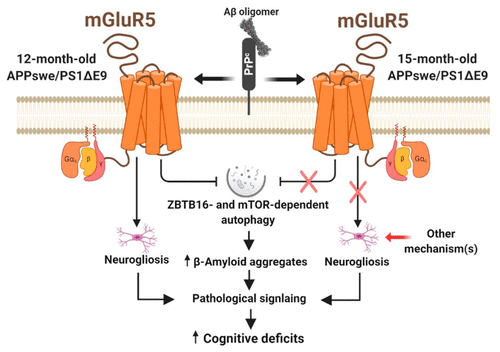当前位置:
X-MOL 学术
›
ACS Pharmacol. Transl. Sci.
›
论文详情
Our official English website, www.x-mol.net, welcomes your
feedback! (Note: you will need to create a separate account there.)
mGluR5 Contribution to Neuropathology in Alzheimer Mice Is Disease Stage-Dependent.
ACS Pharmacology & Translational Science ( IF 4.9 ) Pub Date : 2020-03-12 , DOI: 10.1021/acsptsci.0c00013 Khaled S Abd-Elrahman 1, 1, 2 , Alison Hamilton 1, 1 , Awatif Albaker 1, 1, 3 , Stephen S G Ferguson 1, 1
ACS Pharmacology & Translational Science ( IF 4.9 ) Pub Date : 2020-03-12 , DOI: 10.1021/acsptsci.0c00013 Khaled S Abd-Elrahman 1, 1, 2 , Alison Hamilton 1, 1 , Awatif Albaker 1, 1, 3 , Stephen S G Ferguson 1, 1
Affiliation

|
Alzheimer's disease (AD) is the most prevalent neurodegenerative disease and is characterized by a progressive cognitive decline in affected individuals. Current therapeutic strategies are limited in their efficacy and some have proven to be even less effective at later disease stages or after extended use. We previously demonstrated that chronic inhibition of mGluR5 signaling using the selective negative allosteric modulator (NAM) CTEP in APPswe/PS1ΔE9 mice can rescue cognitive function, activating the ZBTB16-mediated autophagy pathway to reduce Aβ, the principal neurotoxic species in AD brains. Here, we evaluated the efficacy of long-term treatment with CTEP in 6 month old APPswe/PS1ΔE9 mice for either 24 or 36 weeks. CTEP maintained its efficacy in reversing working and spatial memory deficits and mitigating neurogliosis in APPswe/PS1ΔE9 mice when administered for 24 weeks. This was paralleled by a significant reduction in Aβ oligomer and plaque load as a result of autophagy activation via ZBTB16 and mTOR-dependent pathways. However, further extension of CTEP treatment for 36 weeks was found ineffective in reversing memory deficit, neurogliosis, or Aβ-related pathology. We found that this loss in CTEP efficacy in 15 month old APPswe/PS1ΔE9 mice was due to the abolished contribution of ZBTB16 and mTOR-mediated signaling to AD neuropathology at this advanced disease stage. Our findings indicate that the contribution of pathological mGluR5-signaling to AD may shift as the disease progresses. Thus, we provide the first evidence that the underlying pathophysiological mechanism(s) of AD may unfold along the course of the disease and treatment strategies should be modified accordingly to ensure maximal therapeutic outcomes.
中文翻译:

mGluR5 对阿尔茨海默病小鼠神经病理学的贡献取决于疾病阶段。
阿尔茨海默病 (AD) 是最常见的神经退行性疾病,其特征是受影响个体的认知能力逐渐下降。目前的治疗策略的功效有限,并且一些已被证明在疾病后期或长期使用后效果更差。我们之前证明,在 APPswe/PS1ΔE9 小鼠中使用选择性负变构调节剂 (NAM) CTEP 长期抑制 mGluR5 信号传导可以挽救认知功能,激活 ZBTB16 介导的自噬途径以减少 Aβ(AD 大脑中主要的神经毒性物质)。在这里,我们评估了 CTEP 对 6 个月大的 APPswe/PS1ΔE9 小鼠长期治疗 24 或 36 周的疗效。给药 24 周后,CTEP 在逆转 APPswe/PS1ΔE9 小鼠的工作和空间记忆缺陷以及减轻神经胶质增生方面保持了功效。与此同时,由于 ZBTB16 和 mTOR 依赖性途径激活自噬,Aβ 寡聚物和噬菌斑负荷显着减少。然而,进一步延长 CTEP 治疗 36 周被发现对逆转记忆缺陷、神经胶质增生或 Aβ 相关病理无效。我们发现 15 个月大的 APPswe/PS1ΔE9 小鼠中 CTEP 功效的丧失是由于 ZBTB16 和 mTOR 介导的信号传导在这个晚期疾病阶段对 AD 神经病理学的贡献被消除。我们的研究结果表明,病理性 mGluR5 信号传导对 AD 的贡献可能会随着疾病的进展而发生变化。因此,我们提供了第一个证据,表明 AD 的潜在病理生理机制可能会随着疾病的进程而展开,并且应该相应地修改治疗策略以确保最大的治疗结果。
更新日期:2020-04-23
中文翻译:

mGluR5 对阿尔茨海默病小鼠神经病理学的贡献取决于疾病阶段。
阿尔茨海默病 (AD) 是最常见的神经退行性疾病,其特征是受影响个体的认知能力逐渐下降。目前的治疗策略的功效有限,并且一些已被证明在疾病后期或长期使用后效果更差。我们之前证明,在 APPswe/PS1ΔE9 小鼠中使用选择性负变构调节剂 (NAM) CTEP 长期抑制 mGluR5 信号传导可以挽救认知功能,激活 ZBTB16 介导的自噬途径以减少 Aβ(AD 大脑中主要的神经毒性物质)。在这里,我们评估了 CTEP 对 6 个月大的 APPswe/PS1ΔE9 小鼠长期治疗 24 或 36 周的疗效。给药 24 周后,CTEP 在逆转 APPswe/PS1ΔE9 小鼠的工作和空间记忆缺陷以及减轻神经胶质增生方面保持了功效。与此同时,由于 ZBTB16 和 mTOR 依赖性途径激活自噬,Aβ 寡聚物和噬菌斑负荷显着减少。然而,进一步延长 CTEP 治疗 36 周被发现对逆转记忆缺陷、神经胶质增生或 Aβ 相关病理无效。我们发现 15 个月大的 APPswe/PS1ΔE9 小鼠中 CTEP 功效的丧失是由于 ZBTB16 和 mTOR 介导的信号传导在这个晚期疾病阶段对 AD 神经病理学的贡献被消除。我们的研究结果表明,病理性 mGluR5 信号传导对 AD 的贡献可能会随着疾病的进展而发生变化。因此,我们提供了第一个证据,表明 AD 的潜在病理生理机制可能会随着疾病的进程而展开,并且应该相应地修改治疗策略以确保最大的治疗结果。











































 京公网安备 11010802027423号
京公网安备 11010802027423号